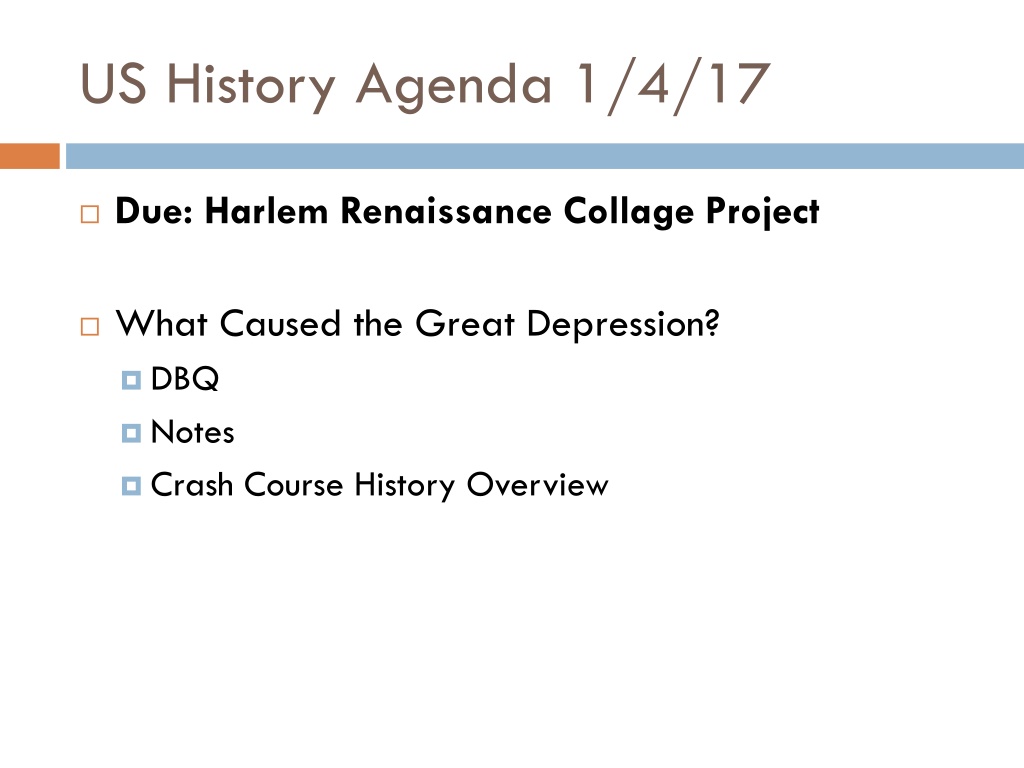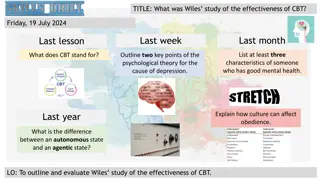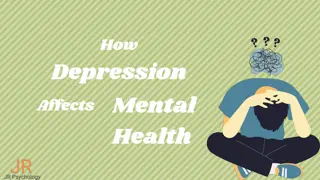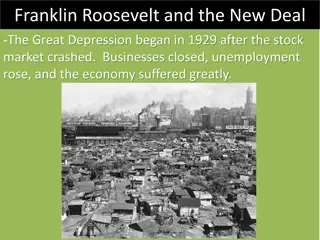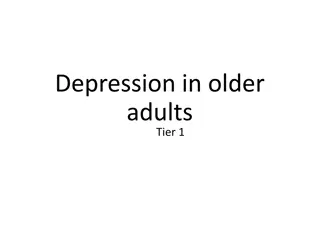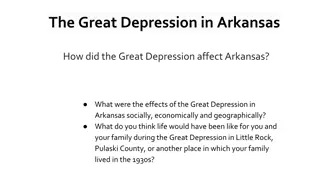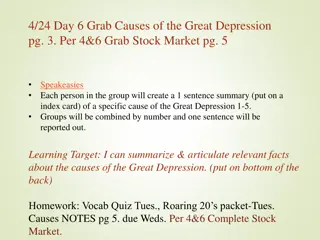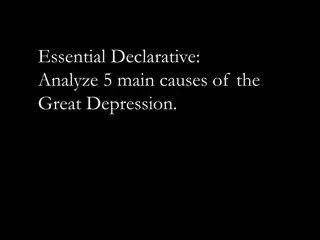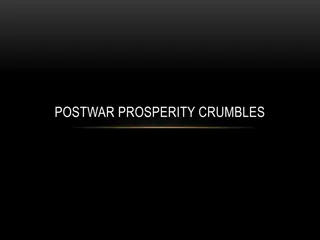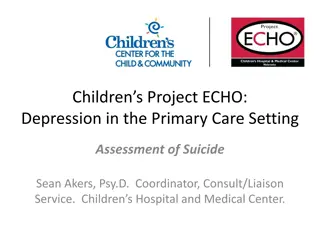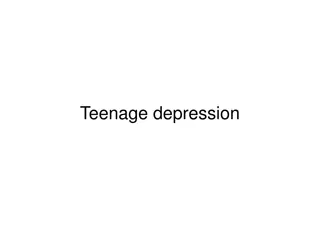Understanding the Causes of the Great Depression in U.S. History
Explore the US History agenda focusing on the Harlem Renaissance, the Great Depression, and the Crash Course History overview. Engage in a game-based learning activity to understand economic fluctuations during the 1930s, analyze the factors that led to the Great Depression, and discuss the consequences. Uncover details about misleading prosperity, the stock market crash, and the key causes of this historic economic downturn.
Download Presentation

Please find below an Image/Link to download the presentation.
The content on the website is provided AS IS for your information and personal use only. It may not be sold, licensed, or shared on other websites without obtaining consent from the author. Download presentation by click this link. If you encounter any issues during the download, it is possible that the publisher has removed the file from their server.
E N D
Presentation Transcript
US History Agenda 1/4/17 Due: Harlem Renaissance Collage Project What Caused the Great Depression? DBQ Notes Crash Course History Overview
Welcome! Procedure 1. Each pair begins the game with 5 points. 2. Before each round of the game, you and your partner will decide among the following three options. The option you choose will determine how many points you earn in that round. Hold Tight: Keep what you have. Play It Safe: Potential for modest gains. Go for the Gold!: Potential for amazing gains. 3. For each round, check the box on your scoring sheet to indicate which option you are choosing. This must be done before the die is rolled and cannot be changed. 4. After the die is rolled, determine how many points you earned in that round. If you Go for the Gold!, points earned are determined by the number rolled. The higher the roll, the greater the number of points. 5. After each round, compute and enter your point total in the Running Total column.
Post-game How did you feel when points were rising? When they dropped dramatically? Which of the three game options produced the worst results in the end? (Hold Tight, Play it Safe, Go for the Gold) How many pairs decided to Go for the Gold sometime during the game? Why did some pairs make other choices? Can you think of any time in history when something like this happened?
THE 1930S AND THE GREAT DEPRESSION
DBQ: What caused the Great Depression? With your group you will have about 4 minutes to go through each station. Make sure you re responses are detailed! Be ready to discuss your responses with the class.
Misleading Prosperity Consumerism was driven by credit installment plans led to debt Uneven distribution of wealth wealthiest 5% earned over 30% of national income Stock market boom was driven by speculation buying on margin Herbert Hoover elected in 1928 defeated Alfred E. Smith (D-NY)
The Crash Black Tuesday - October 29, 1929 panicked investors dump stocks Confidence in the economy disappears thousands of banks failed Businesses failed, unemployment rose
Causes of the Great Depression Unstable Economy: National wealth unevenly distributed More goods than consumers want (overproduction) Many workers didn t see the economic benefits Made economic recovery difficult
Causes of the Great Depression Overspeculation: Buying stocks with borrowed money Used stocks as collateral to buy more stock Stock market based on borrowed money rather than actual value
Causes of the Great Depression Government Policies: Federal Reserve cut interests rates to boost economic growth. 1929: worry about speculation cause FED to limit the money supply (discourage lending) Too little money in circulation to help economy recover after crash.
Depression Humor People blamed President Hoover for the economy Hoovervilles Hoover-blankets (newspapers) Chicken in every pot Rise in dark-humor
US History Agenda 1/5/17 Warm Up: Quote Analysis Movie: Cinderella Man Viewing Guide Homework: Chapter 22 Questions due 1/19
Warm Up How can you frighten a man whose hunger is not only in his own cramped stomach but in the wretched bellies of his children? You can't scare him--he has known a fear beyond every other. John Steinbeck What does this quote mean? What does it say about life during the Great Depression?
Viewing Guide: Cinderella Man James J. Braddock is an up-and-coming boxer finding success and wealth in the late 1920s. The crash of the stock market and the Great Depression quickly change all of that. What struggles did many Americans face during the Great Depression?
How did the Government respond? You will analyze one of four speeches given by President Hoover to the American public during the Great Depression. For your assigned document, you should be able to paraphrase the President s message and answer the following questions: According to the text, what specific policies did Hoover propose to end the Great Depression? According to the text, what role should the federal government play in the recovery? What role should individuals and/or local governments play? If you were a historian, would you rely only on the primary documents to interpret Hoover s response to the Depression? Why/why not? 1. 2. 3.
US History Agenda 1/9/17 Cinderella Man Finish Film
US History Agenda 1/10/17 Cinderella Man Debrief Viewing Guide Activity: Budgeting for the Great Depression
US History Agenda 12/16/15 Warm Up Hoover Political Cartoon Government Action Quick Notes Stations Activity The Dust Bowl
Warm Up: Pair-Share What does this cartoon tell us about Herbert Hoover s Presidency? What evidence are you pulling from the image to support your answer?
The Government Acts Agricultural Marketing Act (1929) Pre crash Relief for farmers & stabilize crop prices Failure, sent prices falling Hawley-Smoot tariff (1930) Highest import tax in history Europe raises their own tariffs Halts international trade Reconstruction Finance Corporation (RFC) Gave government credit to large industries and insurance companies Lent money to banks (for loans)
The Dust Bowl Environmental catastrophe struck the Midwest drought, high winds Okies fled westward to California (Route 66) Struggles of migrant workers detailed in arts Dorothea Lange s photography Woody Guthrie s Dust Bowl Ballads John Steinbeck s The Grapes of Wrath
Stations Activity: The Dust Bowl As a class we will be viewing different documents related to the Dust Bowl in stations . After we examine each station, you will have about 5 minutes to discuss the documents and questions with your small group. Give detailed responses.
US History Agenda 12/17/15 Life During the Great Depression Excerpts: Cinderella Man Discussion 1930 s Consumers Budgeting for the Great Depression Reminder: Chapter 22 Due Friday
Can you budget for the Great Depression?
US History Agenda 12/18/15 Due: Chapter 22 Questions Discuss Music Analysis Happy Days Are Here Again Brother Can You Spare a Dime Life During the Great Depression Activity
Music of the time Happy Days Are Here Again Brother Can You Spare A Dime? What is the tempo of the song? How does the tempo make you feel? What is the tempo of the song? How does the tempo make you feel? In what ways does this song relates to what people were going through during the Great Depression? How does this song relate to the time period right before the stock market crash (1920s)?
Hardships and Suffering During the Great Depression How did the Great Depression impact each of the following groups? Urban Poor African Americans and Latino Americans Rural Poor Single Men Women and Children Put the information into your own words, and be prepared to share your responses with the class!
